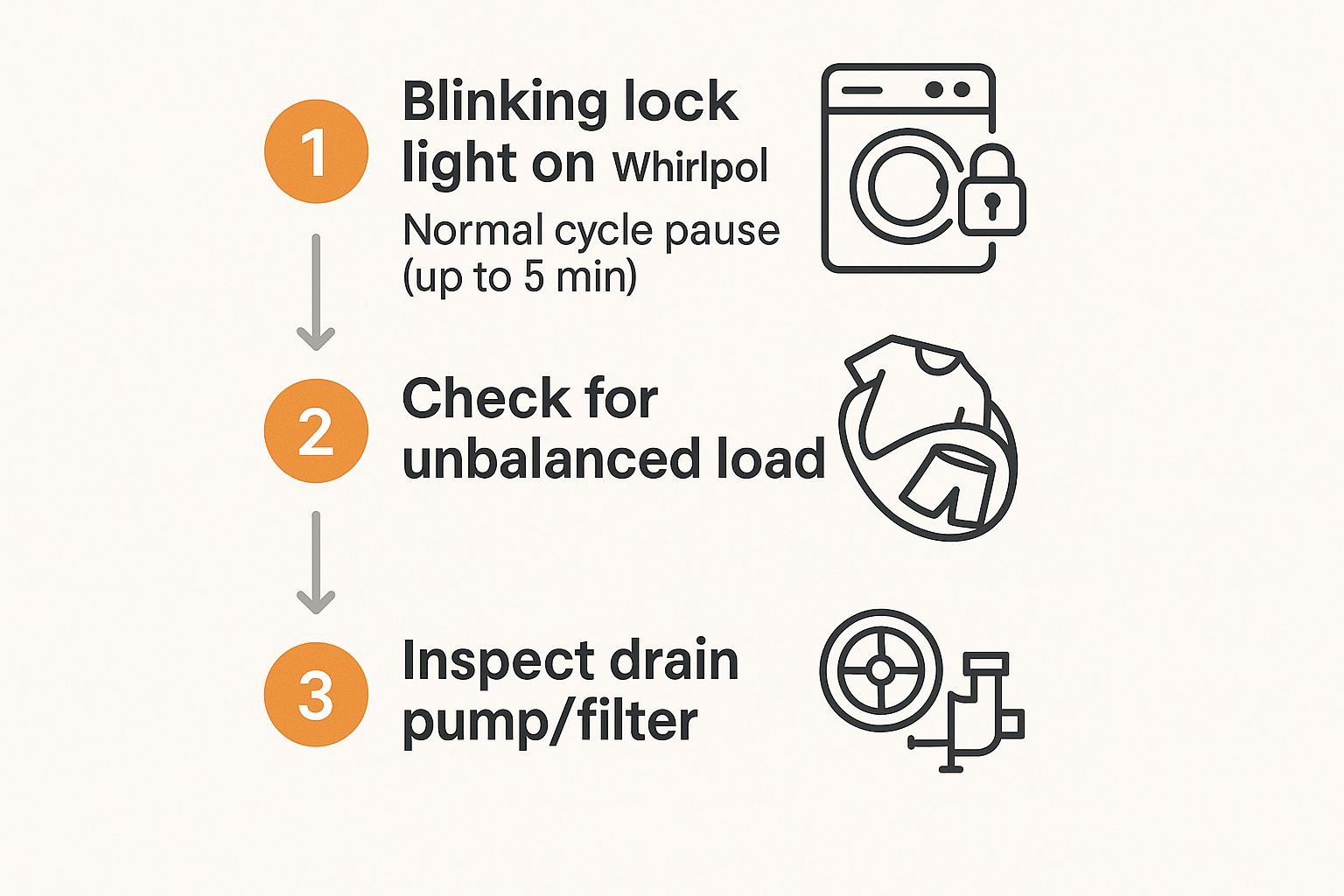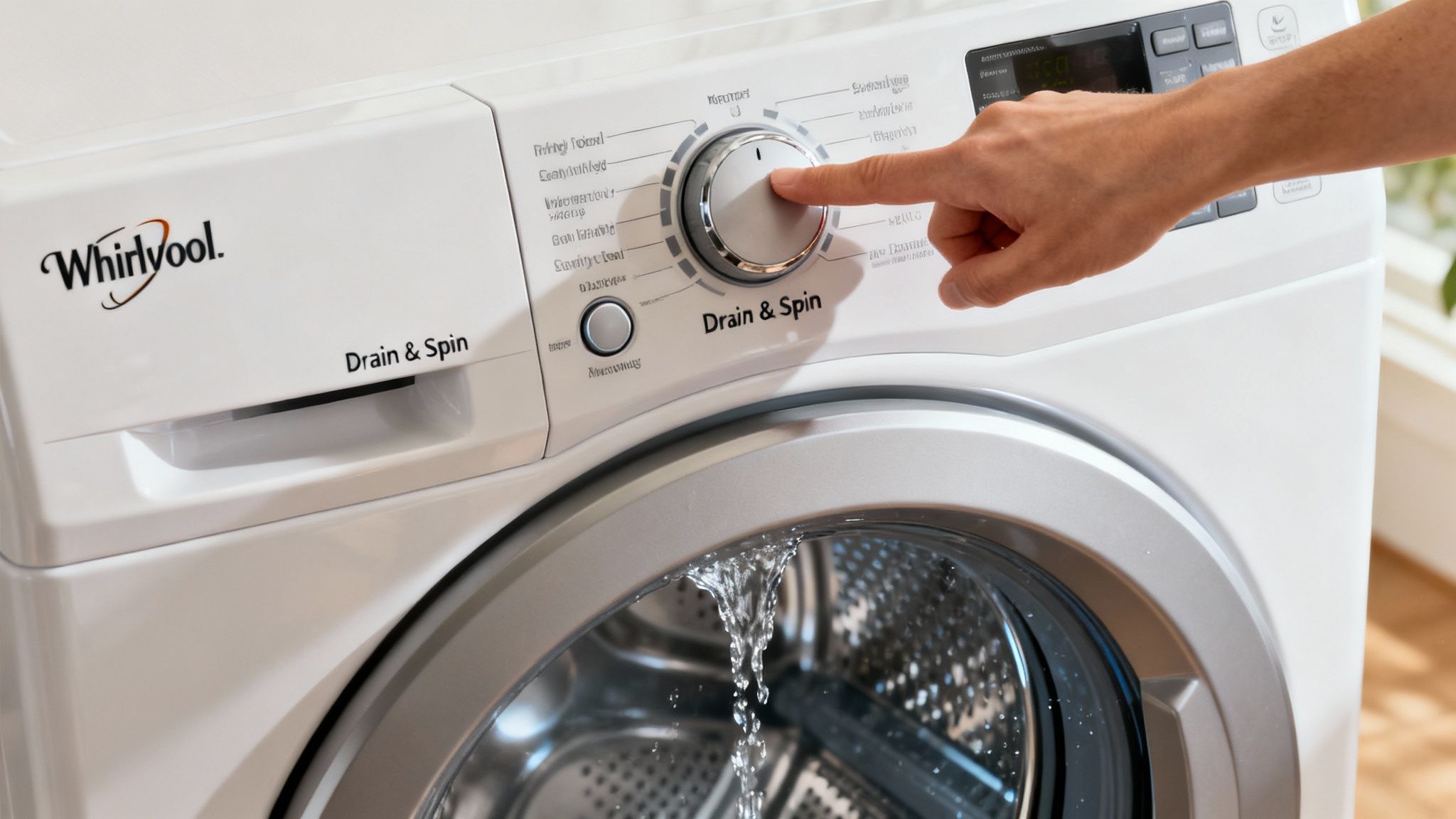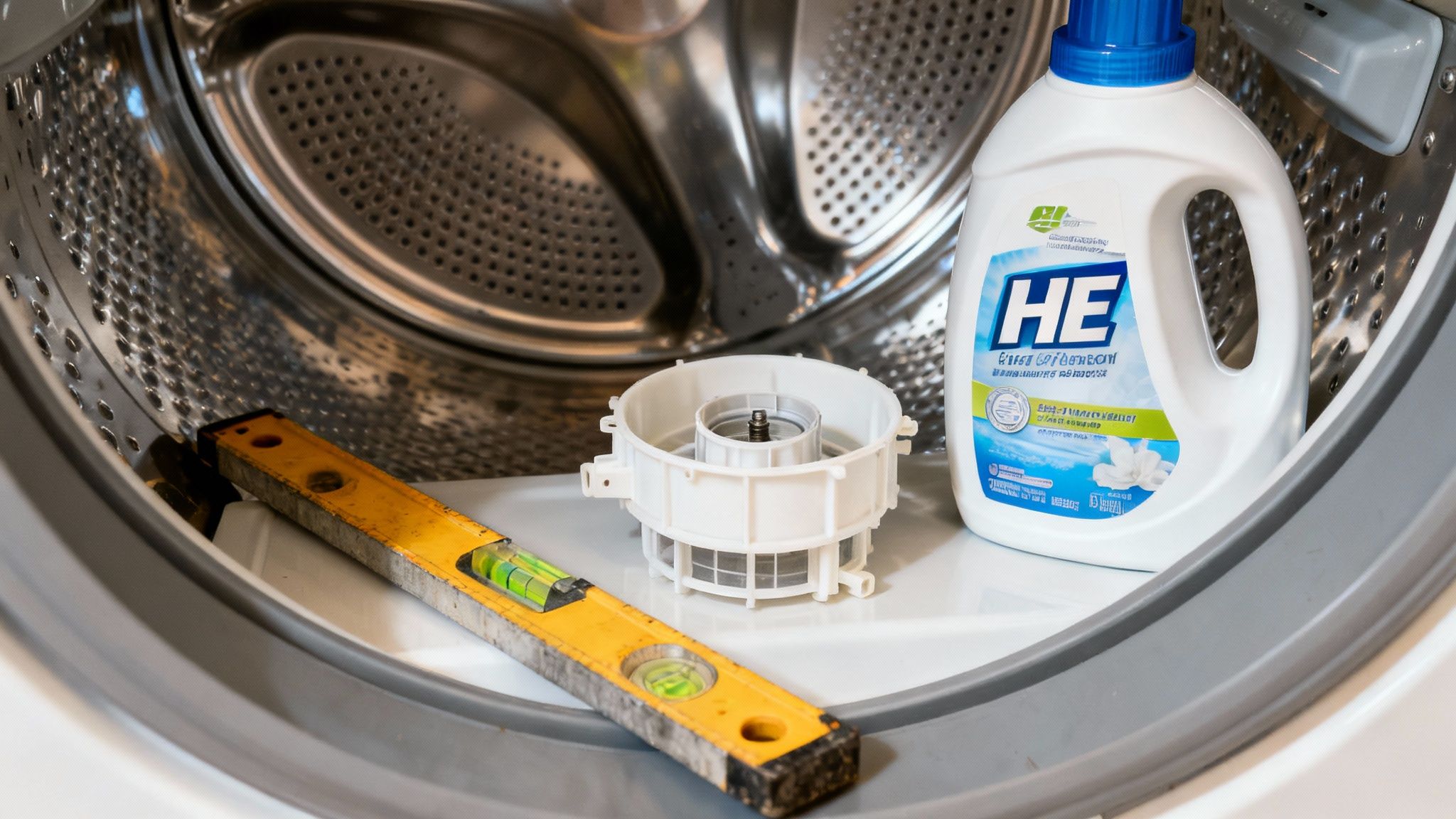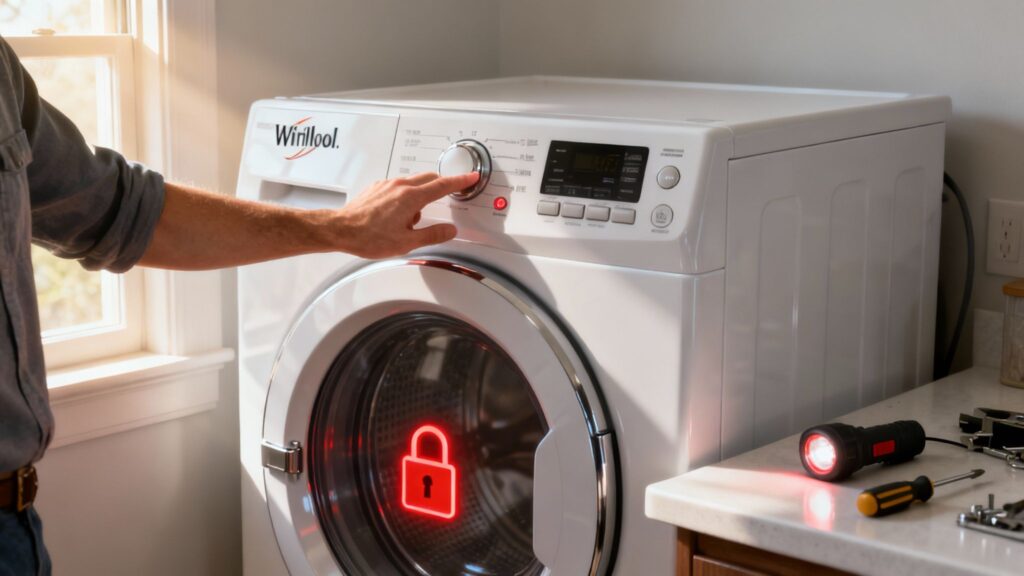That blinking lock light on your Whirlpool washer can be a real head-scratcher. Usually, it's just the machine doing its thing—running a safety check or pausing between cycles. But when that light keeps blinking and your laundry is being held hostage, it's a sign that something needs a closer look. The good news is, you can often figure it out yourself.
Why Your Whirlpool Washer Is Locked
First things first, that blinking red lock icon isn't there just to frustrate you. It's a crucial safety feature. It's designed to keep that door firmly shut during the high-speed spin cycle or when the tub is filled with hot water. No one wants a laundry room flood or a dangerously spinning door. Under normal conditions, the light pops on when you start a load and turns off a few minutes after it's all done.
But what if the cycle is over and the door is still locked? That means the washer's internal brain has detected a problem and is keeping the door locked for safety. For homeowners in places like Plano and Frisco, getting to the bottom of this is the key to getting your machine back on track. If you want to dive deeper into the specifics of your model, Whirlpool's official support page is a great resource for operational guides.
Common Reasons for a Locked Washer Door in Your Plano Home
Before you start thinking about a costly repair, let's run through the usual suspects. More often than not, it's one of these simple issues.
- Normal Cycle Delay: Patience is key. Many modern washers have a built-in cool-down and safety period. Give it a good 3 to 5 minutes after the cycle finishes before you expect the lock to disengage.
- Water in the Drum: This is a big one. If the washer's sensors detect water still in the tub, it will not unlock. It's a safety measure to prevent a mess, and it usually points toward a drainage problem.
- Unbalanced Load: We've all been there. Heavy items like towels or jeans can clump together on one side. The washer senses the imbalance, stops the spin cycle to prevent violent shaking, and keeps the door locked.
- Control Lock (
LoCorLC): Sometimes the simplest answer is the right one. The child lock feature is easy to turn on by accident, which disables all controls and keeps the door locked.
To help you get started, I've put together a quick checklist to help you narrow down the issue before you start pulling things apart.
Quick Diagnostic Checklist for a Locked Whirlpool Washer
Use this checklist to quickly pinpoint the most likely cause before attempting any fixes.
| Symptom | Potential Cause | First Action to Take |
|---|---|---|
| Cycle just finished, light blinking | Normal safety delay | Wait 5 minutes. Don't try to force the door. |
| Washer is off, but you hear water sloshing | Drainage issue | Check the drain hose for kinks and the drain pump filter for clogs. |
| Cycle stopped mid-way with a "UL" or "ub" code | Unbalanced load | Power off the washer. Manually drain it if needed, then redistribute the clothes. |
LoC or LC is on the display, buttons don't work |
Control Lock is on | Press and hold the "Control Lock" or "End of Cycle Signal" button for 3 seconds. |
This table covers the most common scenarios we see. If your situation doesn't fit, the next step is a more hands-on investigation.
This infographic lays out the thought process nicely, from the simple to the more involved checks.

Following these steps will help you figure out if you're dealing with a simple operational quirk or a genuine mechanical issue. If you've given it a few minutes and have checked the load, the drainage system is the next logical place to look—a very common problem our technicians run into all over the McKinney area.
Simple Fixes to Unlock Your Washer Door Fast in the McKinney Area
It’s one of the most frustrating laundry day problems: your clothes are clean, but they're trapped inside a locked Whirlpool washer. Before you pick up the phone to schedule a repair, let's walk through a few simple tricks that almost always solve the problem in minutes. Honestly, these are the very first things our own technicians check when they get to a home in Allen or North Dallas.
Try a Power Cycle First (The Right Way)
The first and most effective fix is a simple power cycle. Think of it as a hard reset for your washer's brain, which can easily clear up the electronic glitches that cause a door to stay locked. But there's a right way and a wrong way to do this. Just unplugging it for ten seconds won't cut it.

For a complete reset, you need to do this:
- Kill the power. Pull the plug right out of the wall. If the outlet is tucked away behind the machine, just flip the correct breaker in your home's electrical panel.
- Walk away for five minutes. This is the crucial part. You have to give the main control board and its internal components enough time to fully discharge all their stored energy. Patience is key.
- Power it back up. Plug the washer back in and give it about 30 seconds to reboot before you try to open the door.
You’d be surprised how often this simple trick works. If the door still won't budge, the problem is likely leftover water in the drum.
Force the Washer to Drain
Your Whirlpool has a built-in safety feature that keeps the door locked if it detects water inside. It’s a smart design to prevent a flood, but it's also a common reason for a whirlpool locked washer, especially if a cycle was stopped midway through.
The fix is to tell the machine to drain itself.
A Quick Word of Warning: Whatever you do, don't try to pry the door open. You're far more likely to snap the handle or break the lock mechanism, turning a simple issue into a much more expensive repair.
Scan your control panel for a "Drain & Spin" cycle. Selecting this tells the washer to do one thing: pump out all the water and then spin the drum. A couple of minutes after the cycle finishes, the door should unlock automatically.
No "Drain & Spin" option? Try pressing and holding the "Cancel" or "Power/Cancel" button for about three seconds. This usually forces the machine to cancel its current program, drain the water, and release the door lock. These kinds of tips are at the heart of DIY appliance repair and can save you a service call fee. For more hands-on advice, you can check out some of our other DIY appliance repair projects.
Let the Error Codes Guide You
If a reset and a drain cycle don't solve it, your washer might be trying to tell you exactly what’s wrong. Look for an error code on the display. Codes like "F5," "F8," or "E1" often point directly to problems with the door lock assembly, the water pump, or a pressure sensor.
Don't ignore these codes. A quick search in your user manual or online can translate them into actionable steps.
And remember, always put safety first. Features like lid locks are there for a reason—to prevent serious injuries from a drum spinning at high speeds. The Consumer Product Safety Commission (CPSC) tracks thousands of appliance-related injuries every year. Before you do anything beyond pressing buttons, unplug the machine. If you've tried all these fixes and you're still locked out, it’s probably time to look at some more advanced solutions.
Advanced Steps for a Stubbornly Locked Lid
So, the simple resets didn't do the trick. If your Whirlpool washer door is still locked tight, it’s time to dig a little deeper. This next part is for those who are comfortable getting a bit more hands-on. We're moving past pushing buttons and into checking the actual hardware that could be causing the jam.

First thing's first—and I can't stress this enough—unplug the washer from the wall. Your safety is the top priority here. Once the machine is completely dead to the world, you can start investigating the lid lock assembly. This is the part on the washer's top where the plastic peg from the lid slots in.
Grab a flashlight and peer into that opening. You'd be surprised what can get in there. I've seen everything from lint buildup and loose threads to small foreign objects blocking the mechanism. If you spot a culprit, use a pair of tweezers or needle-nose pliers to gently fish it out.
Giving the Lid Lock Assembly a Closer Look
If you've cleared out any debris and the lid still won't budge, the lock assembly itself might be damaged. The plastic housing can get brittle over time and crack, or the internal switch could simply be worn out. On most top-loading models, getting to this part is pretty straightforward. You usually just need to remove a few screws from the back of the washer, which lets you slide the whole top panel forward for access.
With the assembly exposed, here's what to look for:
- Cracked Plastic: Even a hairline fracture in the housing can throw off the alignment and prevent the lock from disengaging.
- Loose Wires: Jiggle the wiring harness connected to the lock. A loose or corroded connection can easily interrupt the signal from the control board.
- Burn Marks: Any scorching or discoloration around the electrical connections is a dead giveaway. That means there's been a short, and the entire assembly needs to be replaced.
For many homeowners I've worked with in McKinney and North Dallas, this visual check is where their DIY journey ends. Spotting a cracked part is one thing, but replacing it is another. If you see obvious damage but don't feel confident swapping the part out, this is a great time to call in a pro.
The Manual Release Lifeline
If your main goal is just to rescue your soggy clothes, you're in luck. Most Whirlpool models have a manual release built-in for this very situation. It’s typically a small plastic pull-tab or ring located on the bottom of the lid lock mechanism.
Once you have the top panel open, a firm and steady pull on that tab should manually retract the lock bolt, letting you open the lid. Keep in mind, this is just a temporary fix to get your laundry out. If you have to resort to the manual release, it’s a sure sign the lock assembly has failed and is due for replacement.
When the Lock Isn't the Real Problem
Sometimes, the lid lock is working perfectly fine—it’s just getting bad information from another part of the machine. The washer's main control board can be tricked into keeping the door locked if another component sends it a faulty signal.
Two parts are notorious for this:
- The Water Level Pressure Switch: This little sensor tells the machine how much water is in the drum. If it malfunctions, it might falsely report that the tub is still full of water, forcing the lid to stay locked as a safety precaution.
- The Shift Actuator: This part is responsible for helping the washer switch gears between agitating and spinning. A faulty actuator can leave the control board confused about where it is in the cycle, causing it to keep the lid locked indefinitely.
Figuring out if one of these is the issue usually requires a multimeter and some familiarity with appliance electronics. If you’ve given the lock assembly a thorough inspection and found nothing wrong, the problem is likely hiding deeper in the washer’s system.
When to Call a Professional for Your Locked Washer in North Dallas
While it’s great to roll up your sleeves and try a fix yourself, there are definite times when it’s smarter—and safer—to put the tools down and call in an expert. Knowing when to quit is a skill in itself. Pushing a repair past your comfort zone can quickly turn a minor inconvenience into a major, expensive headache.
The most obvious red flag? A burning smell. If you catch a whiff of anything acrid, like burning plastic, rubber, or an electrical odor, unplug the machine immediately. Don't hesitate. This is a serious sign of a failing motor, a short circuit, or an overheating control board—all of which are potential fire hazards.
Another clear signal is when you’re stuck in a loop. If you’ve tried the basic resets and troubleshooting steps but the same error codes just keep popping back up, it's time to admit defeat. Constantly resetting the machine isn't a fix; it's just delaying the inevitable and ignoring a deeper problem.
When DIY Becomes Risky
Some repairs just aren’t for beginners. If your investigation leads you to a faulty main control board or a full lid lock assembly replacement, it’s a good time to pause. These jobs are more complex than they look, involving delicate electronics and precise connections that require specialized knowledge.
For our readers in Celina and Plano, getting a professional diagnosis at this stage can save you a world of frustration. A seasoned technician can pinpoint whether it's a simple component failure or a symptom of a much larger issue, preventing you from wasting money on parts you don't actually need.
Attempting to fix complex electronics without proper training is a huge gamble. One wrong move could fry the main control board, turning a hundred-dollar repair into a thousand-dollar replacement.
The Hidden Costs of a Failed DIY Repair
Trying to save a few bucks with a DIY fix can backfire in a big way. A 2021 appliance repair industry survey found that over 40% of major appliance repair calls were to fix problems that started as botched DIY attempts.
For washing machines, incorrect lid lock and control board replacements were at the top of the list. These mistakes often increased the final repair bill by an average of 60% because the technician had to fix the original problem and the new damage.
Ultimately, it all comes down to knowing your limits. If you run into any of these situations, your best bet is to find reliable local appliance repair. A pro will get the job done right and safely, giving you peace of mind and protecting your appliance for the long haul.
How to Prevent Your Washer from Locking Up Again

Now that you've managed to get your washer door open, the last thing you want is a repeat performance. The best way to deal with a locked washer is to stop it from happening in the first place. A little routine maintenance can make all the difference, keeping your Whirlpool running smoothly and its door unlocking on command.
Think of it as a quick health checkup for your machine. By dedicating just a few minutes every month to preventative care, you can head off the most common issues that trigger a Whirlpool locked washer error. This is the same advice our technicians give homeowners all the time—a little effort now saves a big headache later.
Build a Simple Maintenance Routine
You don’t need to be a professional technician to keep your washer in top shape. Just work a few key tasks into your regular cleaning schedule. It’ll make a huge difference.
-
Clean the Drain Pump Filter: Honestly, if you only do one thing, do this. A clogged filter is the number one reason for drainage problems, which is a primary culprit for a door that won't unlock. Every couple of months, find the little access door on the front of your washer, unscrew the filter, and clean out any lint, coins, or gunk that's built up.
-
Make Sure It's Level: A machine that wobbles during the spin cycle is a machine under stress. That stress can easily lead to error codes and lockouts. Grab a carpenter's level and place it on top of the washer. If that bubble isn't perfectly centered, just adjust the machine’s feet until it is.
-
Don't Overload It: I know it’s tempting to cram every last sock in there, but an overloaded washer is a recipe for trouble. It can't balance the load correctly, which puts a strain on the motor and can trigger the lock mechanism as a safety measure. A good rule of thumb is to fill the drum about three-quarters full.
The Overlooked Details That Matter
Beyond those core tasks, a couple of smaller details can have a huge impact on your washer's reliability. Paying attention to these can prevent the kind of sensor-related lockouts that frustrate so many people.
Pro Tip: Your washer's sensors are more sensitive than you might think. Using too much detergent—or the wrong kind—creates a mountain of suds. This can trick the water level sensor into thinking the tub is still full of water, keeping the door locked long after the cycle should have ended.
Always use a high-efficiency (HE) detergent and measure it properly. More soap doesn't mean cleaner clothes; it just means more problems for your machine.
This isn't just anecdotal advice, either. Studies have shown that washing machines receiving regular care experience up to 30% fewer service calls. Even better, lid lock failures were reduced by nearly 50% in homes that followed a basic maintenance plan.
Following these preventative steps does more than just avoid a locked door; it extends the life of your appliance. For more tips on keeping all your machines in peak condition, check out our other guides on proactive appliance care.
Common Questions About Whirlpool Washer Locks
Over the years, we've heard just about every question you can imagine from homeowners in Plano, Frisco, and the surrounding areas about their stubborn Whirlpool washers. Here are the most common ones we encounter, along with some quick answers to get you started.
It's helpful to remember that these locking mechanisms aren't just there to be difficult—they're sophisticated safety features. Whirlpool puts a ton of research into this tech to make sure their machines run safely and efficiently. That lid lock is a core part of their modern design philosophy.
This focus on innovation is a huge part of their business. In 2023, Whirlpool Corporation brought in around $19.5 billion in revenue, with their laundry appliances playing a major role. They operate 55 manufacturing and research centers worldwide, all dedicated to developing the very technology that can sometimes leave us scratching our heads. You can see more about Whirlpool's performance and innovation focus here.
Can I Manually Override My Whirlpool Washer Lock?
The short answer is yes, on some models. It's possible to manually release the lock, but it usually involves unplugging the machine and getting under the top panel to access the mechanism. Be warned, though—this isn't a simple fix. It’s easy to damage the lock assembly if you don't know exactly what you're doing, turning a small problem into a bigger one. Think of it as an emergency last resort just to rescue your trapped clothes.
Before you even consider that, if you're a resident here in Plano, try the simple power cycle reset first. It's much safer and often just as effective.
Why Is My Washer Lock Light Blinking After the Cycle Is Finished?
A blinking lock light after the cycle should be over is a classic sign of a communication breakdown. It usually means the washer is still detecting water inside or the main control board hasn't received the "all clear" signal from the lock sensor. The machine is basically telling you, "Hold on, it’s not safe to open yet."
Your first move? Run a "Drain & Spin" cycle. This can often force out any lingering water and solve the problem. If that little light just keeps blinking, you're likely looking at a bigger issue, like a clog in the drain line or a faulty sensor that needs professional attention.
This blinking light is probably one of the top reasons we get called out. It's the washer's way of waving a red flag, and you don't want to ignore it.
How Long Do I Need to Unplug My Washer to Reset It?
A quick unplug and plug back in isn't going to cut it. For a true hard reset that clears the control board's memory, you need to leave your Whirlpool washer unplugged for a solid 5 to 10 minutes.
This gives the internal capacitors enough time to fully discharge, which is what actually wipes the temporary software glitches that often cause the lock to act up in the first place.
Still staring at a locked door? If you've tried these fixes and your Whirlpool washer won't cooperate, it’s time to call in an expert. ThumbUp.Pro offers reliable, professional appliance repair throughout North Dallas, including Allen, Frisco, and McKinney. Our certified technicians have the right tools and hands-on experience to solve the problem without the guesswork. Book your appointment online today and save $20!

